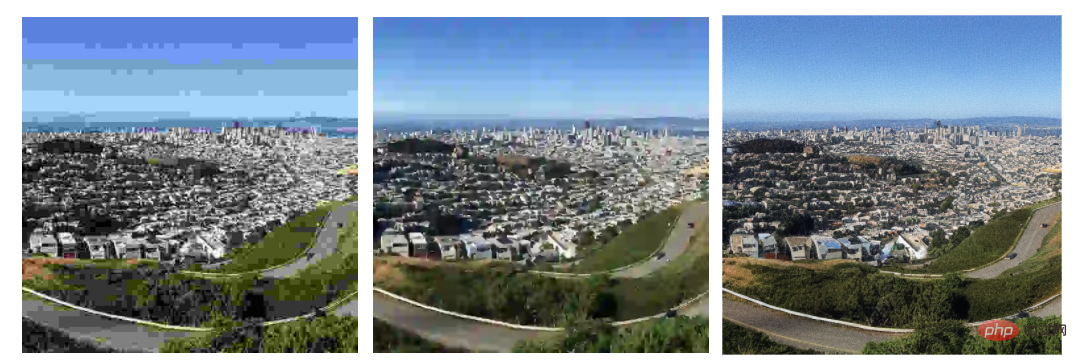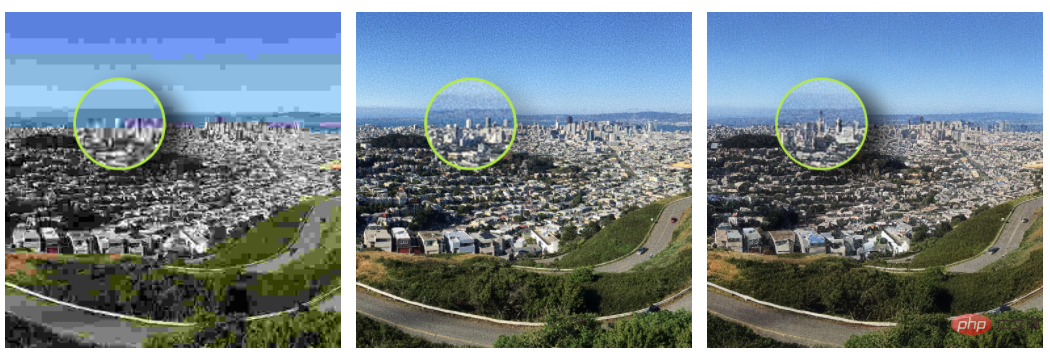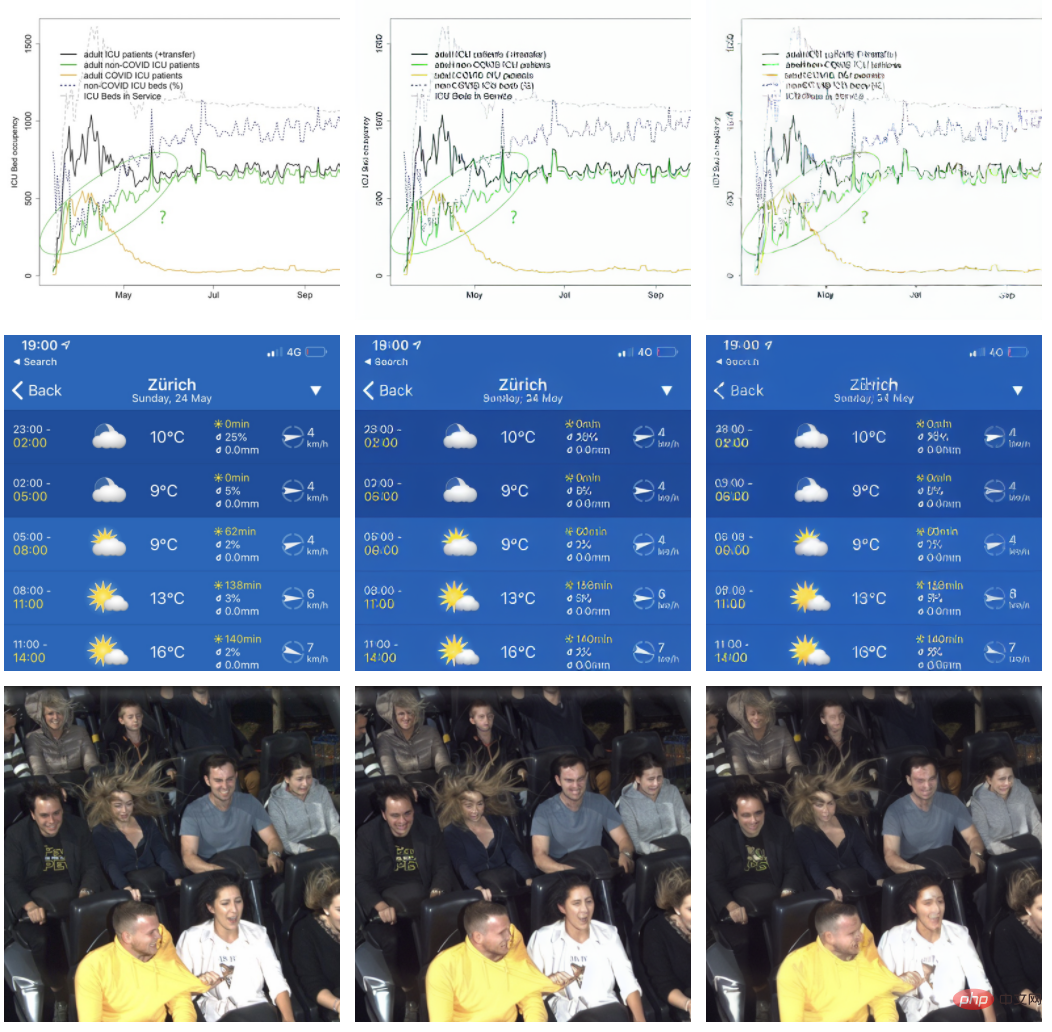 Technology peripherals
Technology peripherals
 AI
AI
 Smaller files, higher quality, can the popular Stable Diffusion compress images?
Smaller files, higher quality, can the popular Stable Diffusion compress images?
Smaller files, higher quality, can the popular Stable Diffusion compress images?
Recently, Stable Diffusion has become an emerging research direction. A blogger named Matthias Bühlmann tried to experimentally explore the power of this model and found that Stable Diffusion is a very powerful lossy image compression codec. He wrote a blog describing this experimental analysis process. The following is the original blog text.
First of all, Matthias Bühlmann gives the compression results of the Stable Diffusion method and JPG and WebP under high compression factor conditions. All results are at a resolution of 512x512 pixels:

San Francisco landscape, from left to right: JPG (6.16kB), WebP (6.80kB), Stable Diffusion: (4.96kB).

Candy shop, from left to right: JPG (5.68kB), WebP (5.71 kB), Stable Diffusion (4.98kB).

#Animal photos, left to right: JPG (5.66 kB), WebP (6.74kB), Stable Diffusion (4.97kB).
#These examples clearly show that compressing images with Stable Diffusion preserves better image quality at smaller file sizes compared to JPG and WebP.
Exploration ExperimentMatthias Bühlmann analyzed the working principle. Stable Diffusion uses three series-trained artificial neural networks:
- Variational Auto Encoder (VAE)
- U-Net
- Text encoding Text Encoder
VAE encodes and decodes images in image space into some underlying spatial representation. The latent spatial representation of the source image (512 x 512, 3x8 or 4x8 bit) will have a lower resolution (64 x 64) and a higher accuracy (4x32 bit).
VAE learns by itself during the training process. As the model is gradually trained, the latent space representation of different versions of the model may look different, such as the latent space representation of Stable Diffusion v1.4 The spatial representation is as follows (remapped to a 4-channel color image):

When re-expanded and interpreted latent features into color values (using alpha channel ), the main features of the image are still visible, and VAE also encodes higher-resolution features into pixel values.
For example, through a VAE encoding/decoding roundtrip, the following results are obtained:

It is worth noting that this roundtrip is not lossless. For example, the white words on the blue tape in the picture are slightly less readable after decoding. The VAE of the Stable Diffusion v1.4 model is generally not very good at representing small text and faces.
We know that the main purpose of Stable Diffusion is to generate images based on text descriptions, which requires the model to operate on the latent spatial representation of the image. The model uses a trained U-Net to iteratively denoise the latent space image, outputting what it "sees" (predicts) in the noise, similar to how we sometimes see clouds as shapes or faces. In the iterative denoising step, a third ML model (text encoder) guides U-Net to try to see different information.
Matthias Bühlmann analyzes how the latent representation generated by VAE can be effectively compressed. He found that sampling the latent representation in VAE or applying existing lossy image compression methods to the latent representation significantly degrades the quality of the reconstructed image, while the VAE decoding process appears to be relatively robust to the quality of the latent representation.
Matthias Bühlmann quantized the latent representation from floating point to 8-bit unsigned integers and found only very small reconstruction errors. As shown in the figure below, left: 32-bit floating point potential representation; middle: ground truth; right: 8-bit integer potential representation.

He also found that through further quantization through palette and dithering algorithms, the results obtained would be unexpectedly good. However, when decoding directly using VAE, the palettized representation leads to some visible artifacts:

Left: 32-bit latent representation; Middle: 8-bit quantized latent representation; Right: palettized 8-bit latent representation with Floyd-Steinberg dither
Palettized representation with Floyd-Steinberg jitter introduces noise, distorting the decoding results. So Matthias Bühlmann used U-Net to remove the noise caused by jitter. After 4 iterations, the reconstructed result is visually very close to the unquantized version:

Reconstructed result (left : palettized representation with Floyd-Steinberg jitter; middle: denoising after four iterations; right: Ground Truth).
#While the results are very good, some artifacts are introduced, such as the glossy shadow on the center symbol above.
Although subjectively, the results of Stable Diffusion compressed images are much better than JPG and WebP, from the perspective of PSNR, SSIM and other indicators, Stable Diffusion has no obvious advantages.
As shown in the figure below, although Stable Diffusion as a codec is much better than other methods in retaining image granularity, it is affected by compression artifacts, the shape of objects in the image, etc. Characteristics subject to change.

Left: JPG compression; middle: Ground Truth; right: Stable Diffusion compression.
It is worth noting that the current Stable Diffusion v1.4 model cannot well preserve text information and facial features with small fonts during the compression process , but the Stable Diffusion v1.5 model has improved in face generation.

##Left: Ground Truth; Middle: after VAE roundtrip (32-bit latent features) ; Right: Results of decoding from palettized denoised 8-bit latent features.
After the blog was published, Matthias Bühlmann’s experimental analysis aroused everyone’s discussion.
Matthias Bühlmann himself believes that the image compression effect of Stable Diffusion is better than expected, and U-Net seems to be able to effectively eliminate the noise introduced by dithering. However, future versions of the Stable Diffusion model may no longer have this image compression feature.

However, some netizens questioned: "VAE itself is used for image compression." For example, the Transformer-based image compression method TIC uses VAE architecture, so Matthias Bühlmann's experiment seems to be overkill.

What do you think of this?
The above is the detailed content of Smaller files, higher quality, can the popular Stable Diffusion compress images?. For more information, please follow other related articles on the PHP Chinese website!

Hot AI Tools

Undresser.AI Undress
AI-powered app for creating realistic nude photos

AI Clothes Remover
Online AI tool for removing clothes from photos.

Undress AI Tool
Undress images for free

Clothoff.io
AI clothes remover

AI Hentai Generator
Generate AI Hentai for free.

Hot Article

Hot Tools

Notepad++7.3.1
Easy-to-use and free code editor

SublimeText3 Chinese version
Chinese version, very easy to use

Zend Studio 13.0.1
Powerful PHP integrated development environment

Dreamweaver CS6
Visual web development tools

SublimeText3 Mac version
God-level code editing software (SublimeText3)

Hot Topics
 1377
1377
 52
52
 The world's most powerful open source MoE model is here, with Chinese capabilities comparable to GPT-4, and the price is only nearly one percent of GPT-4-Turbo
May 07, 2024 pm 04:13 PM
The world's most powerful open source MoE model is here, with Chinese capabilities comparable to GPT-4, and the price is only nearly one percent of GPT-4-Turbo
May 07, 2024 pm 04:13 PM
Imagine an artificial intelligence model that not only has the ability to surpass traditional computing, but also achieves more efficient performance at a lower cost. This is not science fiction, DeepSeek-V2[1], the world’s most powerful open source MoE model is here. DeepSeek-V2 is a powerful mixture of experts (MoE) language model with the characteristics of economical training and efficient inference. It consists of 236B parameters, 21B of which are used to activate each marker. Compared with DeepSeek67B, DeepSeek-V2 has stronger performance, while saving 42.5% of training costs, reducing KV cache by 93.3%, and increasing the maximum generation throughput to 5.76 times. DeepSeek is a company exploring general artificial intelligence
 AI subverts mathematical research! Fields Medal winner and Chinese-American mathematician led 11 top-ranked papers | Liked by Terence Tao
Apr 09, 2024 am 11:52 AM
AI subverts mathematical research! Fields Medal winner and Chinese-American mathematician led 11 top-ranked papers | Liked by Terence Tao
Apr 09, 2024 am 11:52 AM
AI is indeed changing mathematics. Recently, Tao Zhexuan, who has been paying close attention to this issue, forwarded the latest issue of "Bulletin of the American Mathematical Society" (Bulletin of the American Mathematical Society). Focusing on the topic "Will machines change mathematics?", many mathematicians expressed their opinions. The whole process was full of sparks, hardcore and exciting. The author has a strong lineup, including Fields Medal winner Akshay Venkatesh, Chinese mathematician Zheng Lejun, NYU computer scientist Ernest Davis and many other well-known scholars in the industry. The world of AI has changed dramatically. You know, many of these articles were submitted a year ago.
 Hello, electric Atlas! Boston Dynamics robot comes back to life, 180-degree weird moves scare Musk
Apr 18, 2024 pm 07:58 PM
Hello, electric Atlas! Boston Dynamics robot comes back to life, 180-degree weird moves scare Musk
Apr 18, 2024 pm 07:58 PM
Boston Dynamics Atlas officially enters the era of electric robots! Yesterday, the hydraulic Atlas just "tearfully" withdrew from the stage of history. Today, Boston Dynamics announced that the electric Atlas is on the job. It seems that in the field of commercial humanoid robots, Boston Dynamics is determined to compete with Tesla. After the new video was released, it had already been viewed by more than one million people in just ten hours. The old people leave and new roles appear. This is a historical necessity. There is no doubt that this year is the explosive year of humanoid robots. Netizens commented: The advancement of robots has made this year's opening ceremony look like a human, and the degree of freedom is far greater than that of humans. But is this really not a horror movie? At the beginning of the video, Atlas is lying calmly on the ground, seemingly on his back. What follows is jaw-dropping
 KAN, which replaces MLP, has been extended to convolution by open source projects
Jun 01, 2024 pm 10:03 PM
KAN, which replaces MLP, has been extended to convolution by open source projects
Jun 01, 2024 pm 10:03 PM
Earlier this month, researchers from MIT and other institutions proposed a very promising alternative to MLP - KAN. KAN outperforms MLP in terms of accuracy and interpretability. And it can outperform MLP running with a larger number of parameters with a very small number of parameters. For example, the authors stated that they used KAN to reproduce DeepMind's results with a smaller network and a higher degree of automation. Specifically, DeepMind's MLP has about 300,000 parameters, while KAN only has about 200 parameters. KAN has a strong mathematical foundation like MLP. MLP is based on the universal approximation theorem, while KAN is based on the Kolmogorov-Arnold representation theorem. As shown in the figure below, KAN has
 Google is ecstatic: JAX performance surpasses Pytorch and TensorFlow! It may become the fastest choice for GPU inference training
Apr 01, 2024 pm 07:46 PM
Google is ecstatic: JAX performance surpasses Pytorch and TensorFlow! It may become the fastest choice for GPU inference training
Apr 01, 2024 pm 07:46 PM
The performance of JAX, promoted by Google, has surpassed that of Pytorch and TensorFlow in recent benchmark tests, ranking first in 7 indicators. And the test was not done on the TPU with the best JAX performance. Although among developers, Pytorch is still more popular than Tensorflow. But in the future, perhaps more large models will be trained and run based on the JAX platform. Models Recently, the Keras team benchmarked three backends (TensorFlow, JAX, PyTorch) with the native PyTorch implementation and Keras2 with TensorFlow. First, they select a set of mainstream
 Tesla robots work in factories, Musk: The degree of freedom of hands will reach 22 this year!
May 06, 2024 pm 04:13 PM
Tesla robots work in factories, Musk: The degree of freedom of hands will reach 22 this year!
May 06, 2024 pm 04:13 PM
The latest video of Tesla's robot Optimus is released, and it can already work in the factory. At normal speed, it sorts batteries (Tesla's 4680 batteries) like this: The official also released what it looks like at 20x speed - on a small "workstation", picking and picking and picking: This time it is released One of the highlights of the video is that Optimus completes this work in the factory, completely autonomously, without human intervention throughout the process. And from the perspective of Optimus, it can also pick up and place the crooked battery, focusing on automatic error correction: Regarding Optimus's hand, NVIDIA scientist Jim Fan gave a high evaluation: Optimus's hand is the world's five-fingered robot. One of the most dexterous. Its hands are not only tactile
 FisheyeDetNet: the first target detection algorithm based on fisheye camera
Apr 26, 2024 am 11:37 AM
FisheyeDetNet: the first target detection algorithm based on fisheye camera
Apr 26, 2024 am 11:37 AM
Target detection is a relatively mature problem in autonomous driving systems, among which pedestrian detection is one of the earliest algorithms to be deployed. Very comprehensive research has been carried out in most papers. However, distance perception using fisheye cameras for surround view is relatively less studied. Due to large radial distortion, standard bounding box representation is difficult to implement in fisheye cameras. To alleviate the above description, we explore extended bounding box, ellipse, and general polygon designs into polar/angular representations and define an instance segmentation mIOU metric to analyze these representations. The proposed model fisheyeDetNet with polygonal shape outperforms other models and simultaneously achieves 49.5% mAP on the Valeo fisheye camera dataset for autonomous driving
 DualBEV: significantly surpassing BEVFormer and BEVDet4D, open the book!
Mar 21, 2024 pm 05:21 PM
DualBEV: significantly surpassing BEVFormer and BEVDet4D, open the book!
Mar 21, 2024 pm 05:21 PM
This paper explores the problem of accurately detecting objects from different viewing angles (such as perspective and bird's-eye view) in autonomous driving, especially how to effectively transform features from perspective (PV) to bird's-eye view (BEV) space. Transformation is implemented via the Visual Transformation (VT) module. Existing methods are broadly divided into two strategies: 2D to 3D and 3D to 2D conversion. 2D-to-3D methods improve dense 2D features by predicting depth probabilities, but the inherent uncertainty of depth predictions, especially in distant regions, may introduce inaccuracies. While 3D to 2D methods usually use 3D queries to sample 2D features and learn the attention weights of the correspondence between 3D and 2D features through a Transformer, which increases the computational and deployment time.



